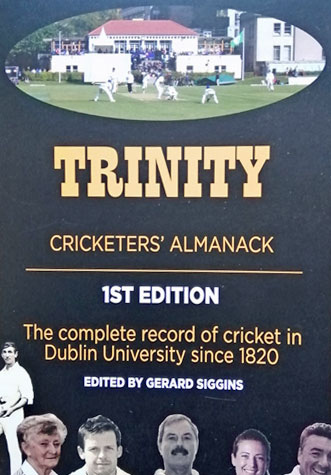
Trinity College has recently published a book of the club's records stretching back two centuries. It's packed with information on the many famous players who graced the oldest - and finest - ground in the country.
As a Christmas present to yourself it's a bargain at 20 euro, and can be bought at Hodges Figgis in Dublin or from trinitycricket.com
In this exclusive extract Ger Siggins tells the story of the first Dublin University man to play first-class cricket …
Trinity’s first first-class cricketer
One hundred and twenty-three Trinity cricketers have played the game at first-class level. Twenty-eight played only in the club’s nine game games that were granted that distinction.
Many more played for Ireland, and at least thirty have played for other sides scattered around the world in England, Australia, South Africa, India, Pakistan, Bermuda, Zimbabwe and Burma.
But the very first of all made his first-class debut and finale in the same game in June 1837, at the home of cricket, Lord’s.
His name was Edward Beversham Harman, and he may have been one of the very earliest Trinity cricketers, though no evidence survives of him playing in Dublin.
He was born in September 1802 in Cork, son of Beversham Harman, a merchant, and Mary Connolly. He studied at Edinburgh where his dissertation was published on November 6th 1820, and was admitted to Trinity that year before being admitted as a fellow at Caius College, Cambridge in November 1830.
He was a doctor and practiced medicine in Bath and at Midhurst in Sussex.
Harman’s brief taste of first-class cricket came for MCC for whom he had played at Lord’s the previous week against Wanstead. He batted 11, making 0* but opened in the second innings when he was out for 0. The MCC side included two lords, a viscount, a Sir, and two MPs, so Harman was mixing in high society.
A week later he was picked to face Oxford University, making his first-class debut alongside fellow Irishman the Earl of Hillsborough. A link to modern Trinity cricket is in his team-mate William Ward MP, who owned Lord’s. His descendent Wilfrid Ward captained Trinity 2s in 2019.
Oxford fielded 11 and MCC 12, but Harman went in last again, and remained unbeaten on 0. In the second innings, with the Earl of Hillsborough absent hurt, he was promoted to go in 11 and was bowled for 0 by Beauclerk to end a most uneventful career without a single run.
Back in Bath he had married Rose Morey in 1827 but by 1841 she was dead. In the census that year he lived at Paragon Buildings in Bath with his daughters Catherine (13) and Elizabeth (9), son Beversham (7), as well as his mother Mary (60), sister Anne (40) and two servants.
In 1843 he married Catherine Esther Dyer (aged 41) but she too died, in May 1847. His daughter Elizabeth passed away the following year, aged 16.
By the 1851 census he was living at Weston Lodge in Bath with his children Beversham (17), and two more daughters Mary Esther (5) and Jane Anne (7). His late wife’s unmarried sister Jane (44) had moved in, presumably to care for the younger children.
His son died the following year, aged 19, and by the 1861 census just Edward and his sister-in-law were living under his roof at 10 Pembroke Place in Kensington.
He was retired and aged 61 when he died in Norfolk in the first week of 1864. Of his five children only his eldest daughter Catherine survived him. His body lies in Bath Abbey cemetery with his second wife, son, and sister-in-law.
He left an estate of £14,000, which can be estimated at well over £1million today.
